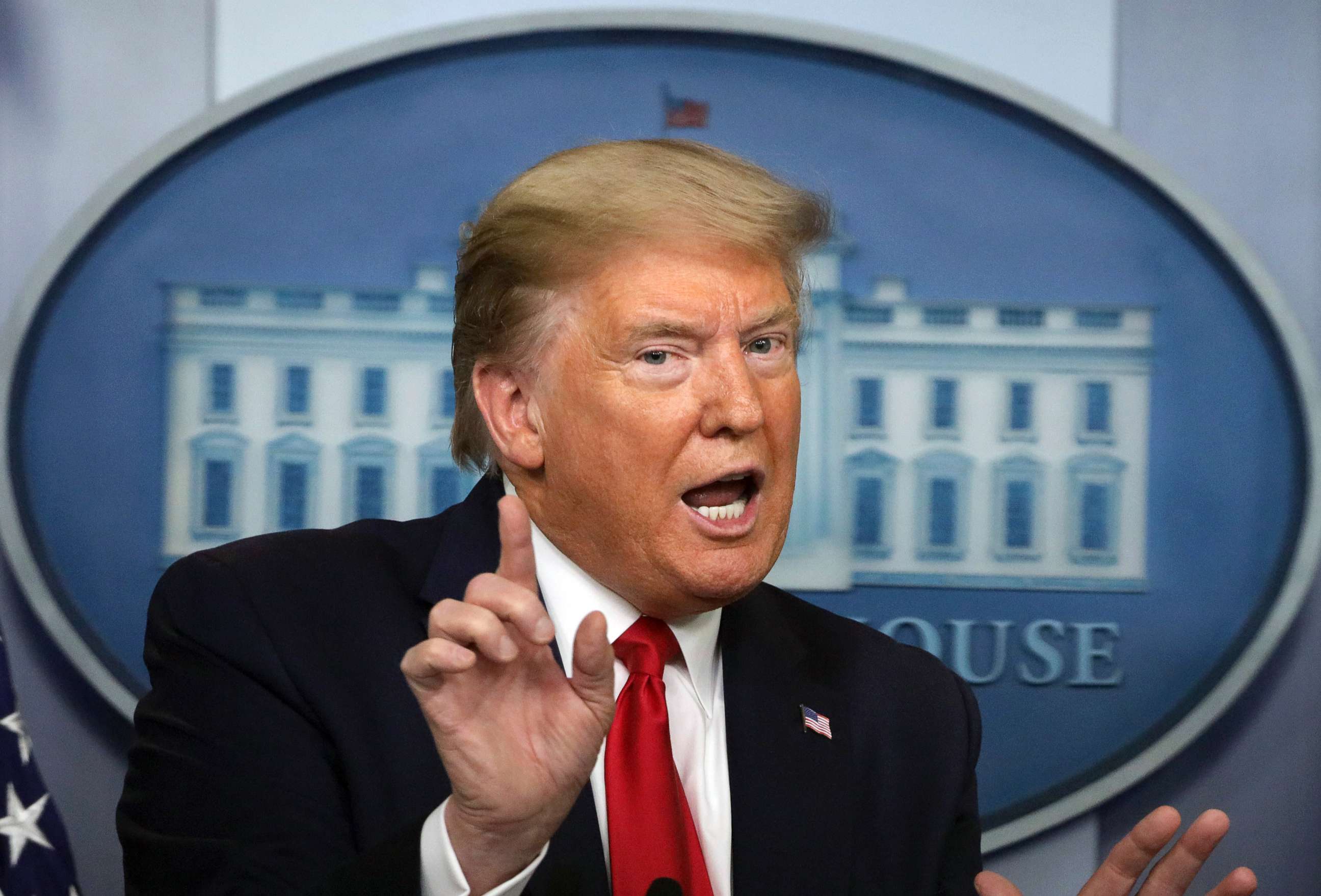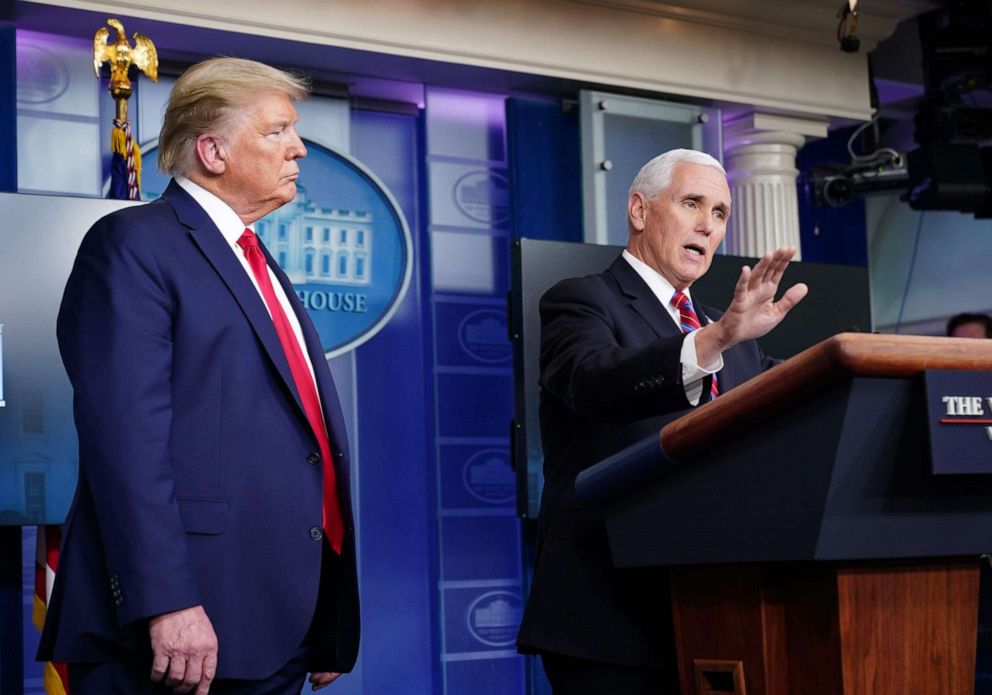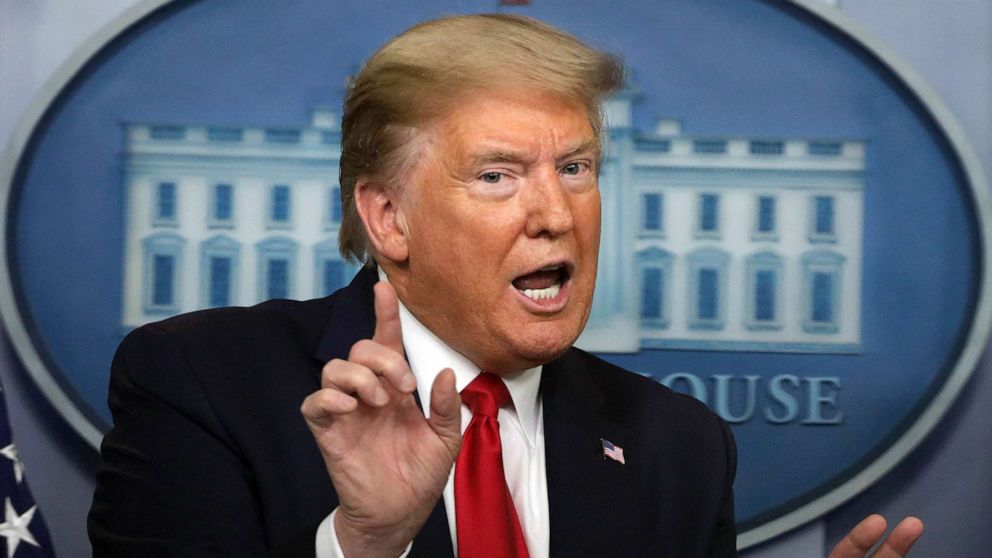Showdown with states: Trump asserts 'total' authority to reopen country, contradicting Constitution and himself
Setting up a potential constitutional showdown between himself and the nation’s governors, President Donald Trump is claiming “total” authority over states in ordering a reopening of the country once the coronavirus pandemic shows signs of receding, even as many governors forge ahead with plans of their own.
“When somebody is the president of the United States, the authority is total. That's the way it's got to be,” Trump claimed Monday during the White House briefing, saying there are “numerous provisions” that grant him the authority to order a state to reopen its economy.

The White House has yet to elaborate on which “provisions” the president was citing, but the president would find himself up against the limits of the U.S. Constitution should he seek to follow through on his threat.
Tune into ABC at 1 p.m. ET and ABC News Live at 4 p.m. ET every weekday for special coverage of the novel coronavirus with the full ABC News team, including the latest news, context and analysis.
The Tenth Amendment to the Constitution states: "The powers not delegated to the United States by the Constitution, nor prohibited by it to the States, are reserved to the States respectively, or to the people.”
Even as Trump insisted “The president of the United States calls the shots,” he also qualified his preference is to work with the states.
“As to whether or not I’ll use that power, we’ll see,” Trump told ABC News Chief White House Correspondent Jonathan Karl. “I would rather work with the states because I like going down to a local government.”
The president’s assertions come after he has, for weeks, sought to shift full responsibility onto the shoulders of governors in making decisions on closures for their states, resisting calls to issue a nationwide stay-at-home order at one time by citing the Constitution’s delegation of power to the states -- the very same constitutional principle he is now insisting he can overrule.
“I leave it up to the governors. The governors know what they’re doing. They’ve been doing a great job,” Trump told Karl on April 3. “I like that from the standpoint of governing, and I like that from the standpoint of even our Constitution.”

While the president offered no details about from where he would extract his assertion of extraordinary authority, Vice President Mike Pence pointed to the president’s emergency powers and authorities in dealing crises similar to the pandemic.
“In the long history of this country, the authority of the president of the United States, during national emergencies, is unquestionably plenary. And you can look back through times of war and other national emergencies,” he explained.
And while the president emphasized the threat of emergency action, Pence made clear that the federal government is staking out a collaborative strategy with the nation’s governors.
“We are going to give them guidance, and as the president indicated, we will continue to respect the leadership and partnership that we forged with every governor in America,” Pence said, emphasizing the cooperation that has already taken place.

States asserting independence
On a practical level, states are already forging ahead charting their own plans for eventual reopening, weighing how best to unwind the closing orders that they orchestrated and implemented on the state and local level, without federal input.
States on the East Coast and the West Coast have formed their own independent regional pacts and are planning to unveil plans to reopen their economies following the stay-at-home orders.
The East Coast group was the first to be announced Monday by Democratic Gov. Andrew Cuomo and includes New York, New Jersey, Pennsylvania, Connecticut, Rhode Island, Delaware and Massachusetts.
Following that announcement, Gov. Gavin Newsom similarly announced the West Coast group -- including his state of California, Oregon and Washington -- was charting its own regional pact.
Washington Gov. Jay Inslee, in a press conference Monday. said that there would not be a strict timeline implemented and that the individual states will have the authority to choose the date to lift restrictions put in place to slow the spread of the coronavirus.
Cuomo snapped back at President Trump’s assertion of “total authority” over states in a phone interview with CNN, making it clear that he does not agree with the Trump's legal analysis.
“The Constitution does not go out the window in an emergency” he said, adding: “We don’t have a king; we have an elected president.”
Cuomo elaborated in a Tuesday appearance on MSNBC, warning the president that if he moves to open the state against his wishes that it would create “a constitutional crisis like you haven't seen in decades" adding that the president's statements in Monday’s White House briefing were "not a bending of the Constitution" but "a breaking of the Constitution."
"If he says to me, 'I declare it open,' and that is a public health risk or it's reckless with the welfare of the people of my state, I will oppose it," he said. "And then we will have a constitutional crisis like you haven't seen in decades, where states tell the federal government, 'We're not going to follow your order.' It would be terrible for this country. It would be terrible for this president."
In a seeming reaction to the New York governor's public criticism, President Trump fired off a tweet Tuesday saying that he’s provided all of the medical supplies that Cuomo has been “begging” for daily and that now “he seems to want Independence! That won’t happen!”
“Cuomo’s been calling daily, even hourly, begging for everything, most of which should have been the state’s responsibility, such as new hospitals, beds, ventilators, etc. I got it all done for him, and everyone else, and now he seems to want Independence! That won’t happen!,” the president tweeted.
What to know about coronavirus:
- How it started and how to protect yourself: coronavirus explained
- What to do if you have symptoms: coronavirus symptoms
- Tracking the spread in the US and Worldwide: coronavirus map




